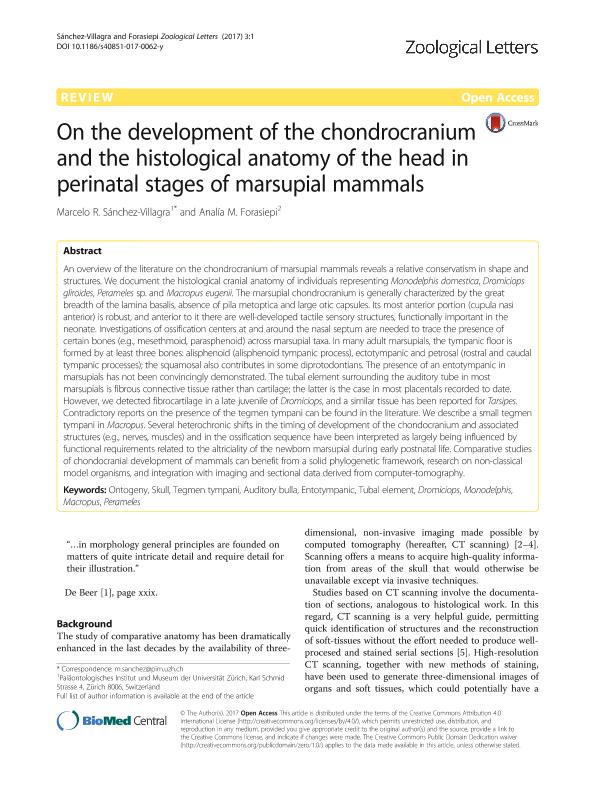Mostrar el registro sencillo del ítem
dc.contributor.author
Sánchez Villagra, Marcelo R.
dc.contributor.author
Forasiepi, Analia Marta

dc.date.available
2018-11-05T15:42:22Z
dc.date.issued
2017-02
dc.identifier.citation
Sánchez Villagra, Marcelo R.; Forasiepi, Analia Marta; On the development of the chondrocranium and the histological anatomy of the head in perinatal stages of marsupial mammals; BioMed Central Ltd.; Zoological Letters; 3; 1; 2-2017; 1-33
dc.identifier.issn
2056-306X
dc.identifier.uri
http://hdl.handle.net/11336/63610
dc.description.abstract
An overview of the literature on the chondrocranium of marsupial mammals reveals a relative conservatism in shape and structures. We document the histological cranial anatomy of individuals representing Monodelphis domestica, Dromiciops gliroides, Perameles sp. and Macropus eugenii. The marsupial chondrocranium is generally characterized by the great breadth of the lamina basalis, absence of pila metoptica and large otic capsules. Its most anterior portion (cupula nasi anterior) is robust, and anterior to it there are well-developed tactile sensory structures, functionally important in the neonate. Investigations of ossification centers at and around the nasal septum are needed to trace the presence of certain bones (e.g., mesethmoid, parasphenoid) across marsupial taxa. In many adult marsupials, the tympanic floor is formed by at least three bones: alisphenoid (alisphenoid tympanic process), ectotympanic and petrosal (rostral and caudal tympanic processes); the squamosal also contributes in some diprotodontians. The presence of an entotympanic in marsupials has not been convincingly demonstrated. The tubal element surrounding the auditory tube in most marsupials is fibrous connective tissue rather than cartilage; the latter is the case in most placentals recorded to date. However, we detected fibrocartilage in a late juvenile of Dromiciops, and a similar tissue has been reported for Tarsipes. Contradictory reports on the presence of the tegmen tympani can be found in the literature. We describe a small tegmen tympani in Macropus. Several heterochronic shifts in the timing of development of the chondocranium and associated structures (e.g., nerves, muscles) and in the ossification sequence have been interpreted as largely being influenced by functional requirements related to the altriciality of the newborn marsupial during early postnatal life. Comparative studies of chondocranial development of mammals can benefit from a solid phylogenetic framework, research on non-classical model organisms, and integration with imaging and sectional data derived from computer-tomography.
dc.format
application/pdf
dc.language.iso
eng
dc.publisher
BioMed Central Ltd.
dc.rights
info:eu-repo/semantics/openAccess
dc.rights.uri
https://creativecommons.org/licenses/by-nc-sa/2.5/ar/
dc.subject
Auditory Bulla
dc.subject
Dromiciops
dc.subject
Entotympanic
dc.subject
Macropus
dc.subject
Monodelphis
dc.subject
Ontogeny
dc.subject
Perameles
dc.subject
Skull
dc.subject
Tegmen Tympani
dc.subject
Tubal Element
dc.subject.classification
Otras Ciencias Biológicas

dc.subject.classification
Ciencias Biológicas

dc.subject.classification
CIENCIAS NATURALES Y EXACTAS

dc.title
On the development of the chondrocranium and the histological anatomy of the head in perinatal stages of marsupial mammals
dc.type
info:eu-repo/semantics/article
dc.type
info:ar-repo/semantics/artículo
dc.type
info:eu-repo/semantics/publishedVersion
dc.date.updated
2018-10-23T14:41:13Z
dc.journal.volume
3
dc.journal.number
1
dc.journal.pagination
1-33
dc.journal.pais
Reino Unido

dc.journal.ciudad
Londres
dc.description.fil
Fil: Sánchez Villagra, Marcelo R.. Universitat Zurich; Suiza
dc.description.fil
Fil: Forasiepi, Analia Marta. Consejo Nacional de Investigaciones Científicas y Técnicas. Centro Científico Tecnológico Conicet - Mendoza. Instituto Argentino de Nivología, Glaciología y Ciencias Ambientales. Provincia de Mendoza. Instituto Argentino de Nivología, Glaciología y Ciencias Ambientales. Universidad Nacional de Cuyo. Instituto Argentino de Nivología, Glaciología y Ciencias Ambientales; Argentina
dc.journal.title
Zoological Letters
dc.relation.alternativeid
info:eu-repo/semantics/altIdentifier/doi/https://dx.doi.org/10.1186/s40851-017-0062-y
dc.relation.alternativeid
info:eu-repo/semantics/altIdentifier/url/https://zoologicalletters.biomedcentral.com/articles/10.1186/s40851-017-0062-y
Archivos asociados
